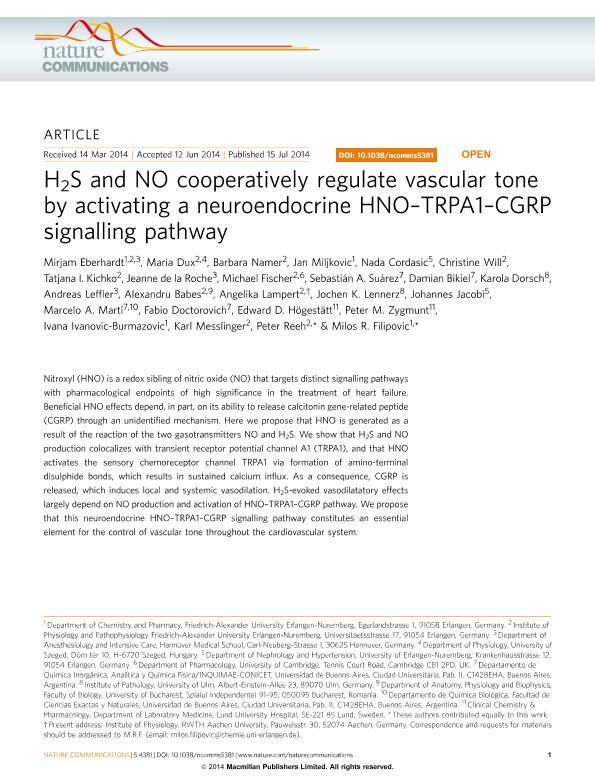Artículo
H2S and NO cooperatively regulate vascular tone by activating a neuroendocrine HNO-TRPA1-CGRP signalling pathway
Eberhardt, Mirjam; Dux, Maria; Namer, Barbara; Miljkovic, Jan; Cordasic, Nada; Will, Christine; Kichko, Tatjana I.; De La Roche, Jeanne; Fischer, Michael; Suarez, Sebastian ; Bikiel, Damian Ezequiel
; Bikiel, Damian Ezequiel ; Dorsch, Karola; Leffler, Andreas; Babes, Alexandru; Lampert, Angelika; Lennerz, Jochen K.; Jacobi, Johannes; Marti, Marcelo Adrian
; Dorsch, Karola; Leffler, Andreas; Babes, Alexandru; Lampert, Angelika; Lennerz, Jochen K.; Jacobi, Johannes; Marti, Marcelo Adrian ; Doctorovich, Fabio
; Doctorovich, Fabio ; Högestätt, Edward D.; Zygmunt, Peter M.; Ivanovic-Burmazovic, Ivana; Messlinger, Karl; Reeh, Peter; Filipovic, Milos R.
; Högestätt, Edward D.; Zygmunt, Peter M.; Ivanovic-Burmazovic, Ivana; Messlinger, Karl; Reeh, Peter; Filipovic, Milos R.
 ; Bikiel, Damian Ezequiel
; Bikiel, Damian Ezequiel ; Dorsch, Karola; Leffler, Andreas; Babes, Alexandru; Lampert, Angelika; Lennerz, Jochen K.; Jacobi, Johannes; Marti, Marcelo Adrian
; Dorsch, Karola; Leffler, Andreas; Babes, Alexandru; Lampert, Angelika; Lennerz, Jochen K.; Jacobi, Johannes; Marti, Marcelo Adrian ; Doctorovich, Fabio
; Doctorovich, Fabio ; Högestätt, Edward D.; Zygmunt, Peter M.; Ivanovic-Burmazovic, Ivana; Messlinger, Karl; Reeh, Peter; Filipovic, Milos R.
; Högestätt, Edward D.; Zygmunt, Peter M.; Ivanovic-Burmazovic, Ivana; Messlinger, Karl; Reeh, Peter; Filipovic, Milos R.
Fecha de publicación:
07/2014
Editorial:
Nature Publishing Group
Revista:
Nature Communications
ISSN:
2041-1723
Idioma:
Inglés
Tipo de recurso:
Artículo publicado
Clasificación temática:
Resumen
Nitroxyl (HNO) is a redox sibling of nitric oxide (NO) that targets distinct signalling pathways with pharmacological endpoints of high significance in the treatment of heart failure. Beneficial HNO effects depend, in part, on its ability to release calcitonin gene-related peptide (CGRP) through an unidentified mechanism. Here we propose that HNO is generated as a result of the reaction of the two gasotransmitters NO and H 2 S. We show that H 2 S and NO production colocalizes with transient receptor potential channel A1 (TRPA1), and that HNO activates the sensory chemoreceptor channel TRPA1 via formation of amino-terminal disulphide bonds, which results in sustained calcium influx. As a consequence, CGRP is released, which induces local and systemic vasodilation. H 2 S-evoked vasodilatatory effects largely depend on NO production and activation of HNO-TRPA1-CGRP pathway. We propose that this neuroendocrine HNO-TRPA1-CGRP signalling pathway constitutes an essential element for the control of vascular tone throughout the cardiovascular system.
Palabras clave:
H2s
,
Hno
,
No
,
SIGNALLING
Archivos asociados
Licencia
Identificadores
Colecciones
Articulos(INQUIMAE)
Articulos de INST.D/QUIM FIS D/L MATERIALES MEDIOAMB Y ENERGIA
Articulos de INST.D/QUIM FIS D/L MATERIALES MEDIOAMB Y ENERGIA
Citación
Eberhardt, Mirjam; Dux, Maria; Namer, Barbara; Miljkovic, Jan; Cordasic, Nada; et al.; H2S and NO cooperatively regulate vascular tone by activating a neuroendocrine HNO-TRPA1-CGRP signalling pathway; Nature Publishing Group; Nature Communications; 5; 7-2014; 1-17
Compartir
Altmétricas



